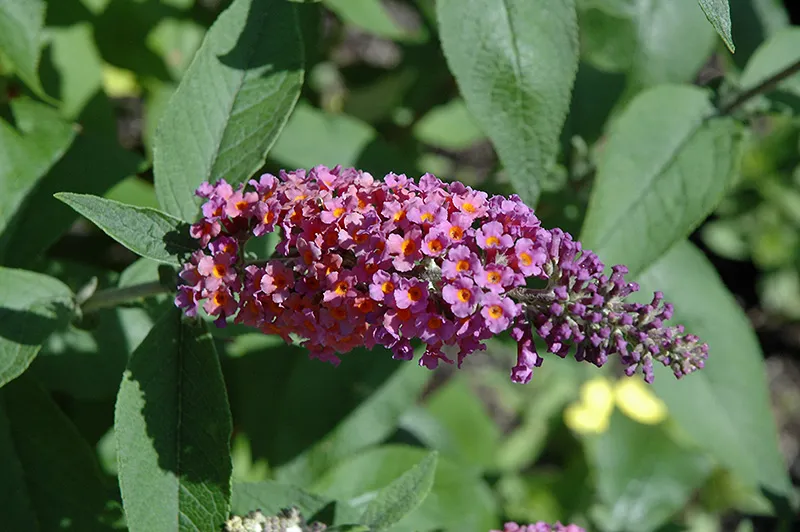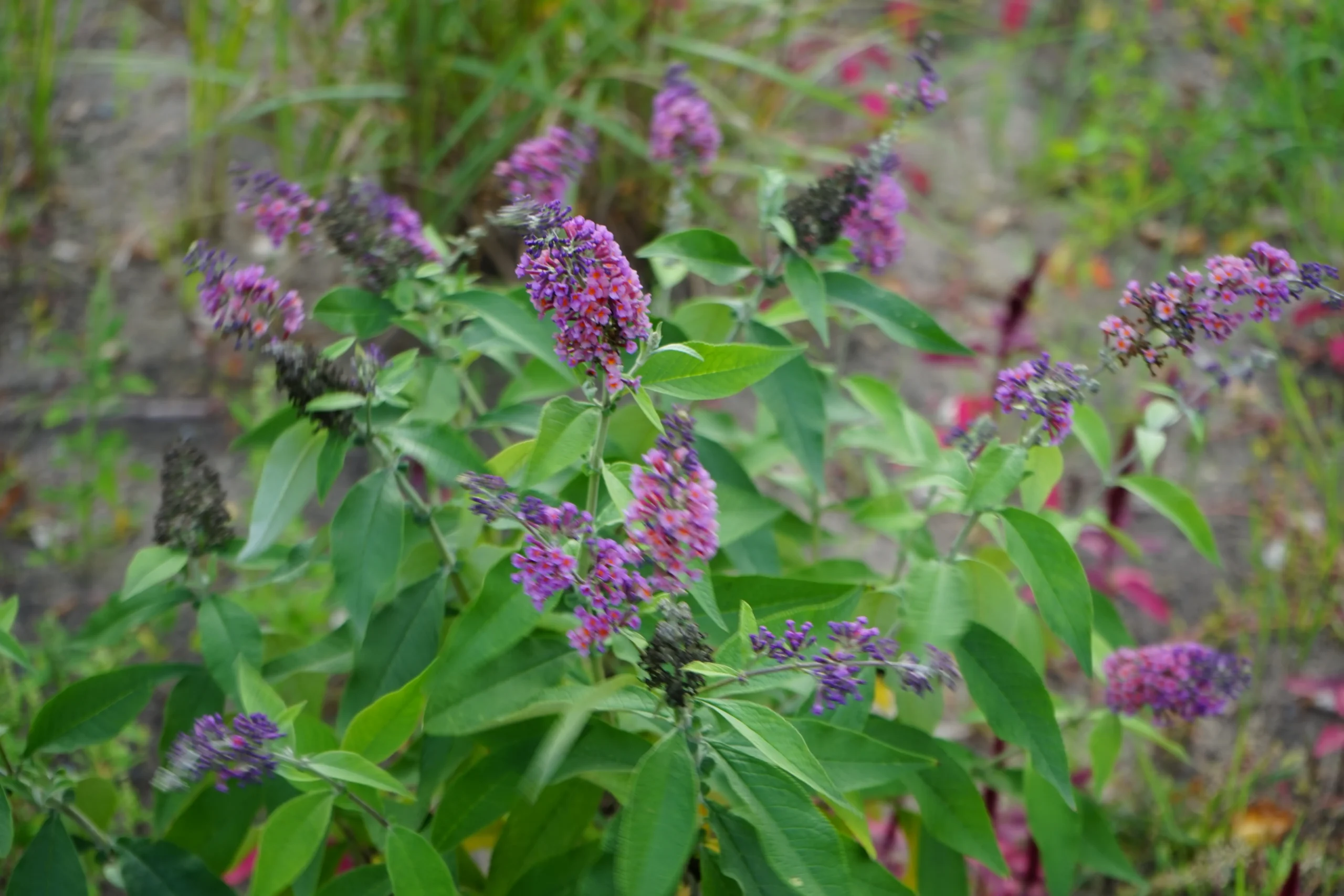Family: Butterfly Bush
Type: Shrub
Other Common Name: Summer Lilac

The BiColor Butterfly Bush (Buddleja davidii ‘Bicolor’) is a stunning addition to any garden, known for its unique two-toned flowers that attract butterflies and other pollinators. This fast-growing shrub features blooms that combine shades of lavender and orange, creating a striking visual effect from early summer to fall.
It’s an easy-to-grow plant that requires minimal care, making it suitable for gardeners of all skill levels. With its ability to adapt to various soil types and its drought tolerance once established, the BiColor Butterfly Bush is a resilient choice for many landscapes. The plant’s fragrant flowers not only add beauty but also support local wildlife, offering nectar to bees, butterflies, and hummingbirds.
Hardiness Zone: 5b-9b
Deer Resistant: Yes
Pet Friendly: Yes
Moisture Preference: Dry to moist
Sun Needs: Full sun
Drought Tolerance (Xeriscape): Yes
Growth Rate: Fast
Average Height (feet): 6
Average Spread (feet): 4
Average Life Span (years): 20
Form: Upright spreading
Flower Color: Purple
Secondary Flower Color: Harvest
Flower Eye Color: Orange
Bloom Season: From early summer to mid fall
Foliage Color: Green
Foliage Shape: Narrow
Bark Color: Brown
Bark Texture: Smooth
Integrating a BiColor Butterfly Bush into your garden can provide a continuous display of vibrant colors and lively activity from pollinators. Its upright growth habit and medium size make it an excellent choice for borders, mixed beds, or as a focal point in a butterfly garden.
Planting several bushes together can create an eye-catching hedge or privacy screen that’s alive with color and movement. For an appealing contrast, pair it with plants that have dark foliage or those that bloom in complementary colors.
This bush is also well-suited for large containers, allowing you to enjoy its beauty on patios or in other outdoor living spaces.

The informal charm of the BiColor Butterfly Bush fits perfectly into the relaxed and abundant feel of a cottage garden. Its vibrant blooms and ability to attract wildlife enhance the garden's whimsical nature.
This butterfly bush is a must-have for any pollinator garden, attracting a variety of bees, butterflies, and birds with its colorful and fragrant flowers, contributing to the biodiversity of your garden.
In a contemporary garden, the BiColor Butterfly Bush can add a splash of color and organic texture. Its distinct flower colors work well against modern landscaping elements, providing a natural contrast to minimalist designs.
Create a lively border along walkways or fences with the BiColor Butterfly Bush to enjoy up-close interactions with butterflies and hummingbirds. Incorporate it into a sensory garden, where its fragrant blooms and the sound of visiting pollinators can be fully appreciated. For a dynamic, multi-season display, mix it with perennials that offer interest in other seasons, ensuring your garden remains vibrant from spring through fall.
Select our pre-made garden layouts to create a landscape that’s uniquely yours. Simple, smart, and customizable!
In spring, the BiColor Butterfly Bush begins to produce lush, green foliage, setting the stage for the blooms that will emerge in the summer.
Summer sees the BiColor Butterfly Bush in full glory, with its unique lavender and orange flowers attracting a flurry of pollinator activity, creating a lively and colorful garden scene.
As fall approaches, the BiColor Butterfly Bush continues to bloom, adding warmth and color to the garden as the temperature begins to drop, until the first frost.
During winter, the BiColor Butterfly Bush becomes dormant, losing its leaves and flowers, but its structure can still provide interest, especially when frosted or covered in snow.
The BiColor Butterfly Bush prefers a sunny location where it can receive at least six hours of direct sunlight each day. This exposure maximizes bloom production and ensures the healthiest growth.
Full sun is essential for the BiColor Butterfly Bush to thrive and produce its characteristic vibrant blooms. It can tolerate partial shade, but flowering will be reduced.
Well-drained soil is crucial for the BiColor Butterfly Bush. It is adaptable to a variety of soil types, including clay, loam, and sandy soils, as long as they are well-drained.
Space BiColor Butterfly Bushes about 5 to 6 feet apart. This spacing allows ample room for growth and air circulation, reducing the risk of disease.
The best time to plant the BiColor Butterfly Bush is in the spring after the threat of frost has passed or in the fall, allowing it to establish before the onset of winter.
Dig a hole twice the width and the same depth as the root ball. Place the bush in the hole, backfill with soil, and water thoroughly. Mulching can help retain moisture and suppress weeds.
Regular watering is important during the first growing season to establish a deep, extensive root system. Once established, the BiColor Butterfly Bush is drought-tolerant, requiring only occasional watering during dry spells.
Feed in early spring with a slow-release, balanced fertilizer to encourage healthy growth and abundant flowering.
Prune in late winter or early spring before new growth begins. This encourages bushier growth, more flowers, and a more manageable size.
Apply fertilizer as new growth appears. Prune to shape the bush and remove any dead or damaged wood.
Water the bush during prolonged dry periods. Deadhead spent blooms to encourage continued flowering.
Reduce watering as the plant begins to go dormant. Apply a layer of mulch around the base to protect the roots over the winter.
No special care is needed in winter in most climates. In colder zones, ensure the bush is well-mulched to protect it from freezing temperatures.
The BiColor Butterfly Bush is a fast-growing plant, capable of reaching its full size of 6 to 8 feet tall and wide within a couple of seasons.
In some areas, Butterfly Bushes can be considered invasive. It’s important to check local guidelines and consider responsible gardening practices, such as deadheading to prevent self-seeding.
Yes, the BiColor Butterfly Bush can be easily propagated from cuttings taken in late spring or early summer, allowing gardeners to create more plants for their gardens or to share.
Sign up below to get exclusive deals, discounts, and new plant collections—delivered straight to your inbox! Plus, stay inspired with the latest gardening tips, landscaping trends, and DIY garden ideas. Start growing with us today!
A big thank you for subscribing to the PBN Design newsletter.
We're thrilled to have you join our community. Get ready for exciting updates, insightful content, and more delivered straight to your inbox.
Stay tuned!
Go backA big thank you for subscribing to the PBN Design newsletter.
We're thrilled to have you join our community. Get ready for exciting updates, insightful content, and more delivered straight to your inbox.
Stay tuned!
Go back